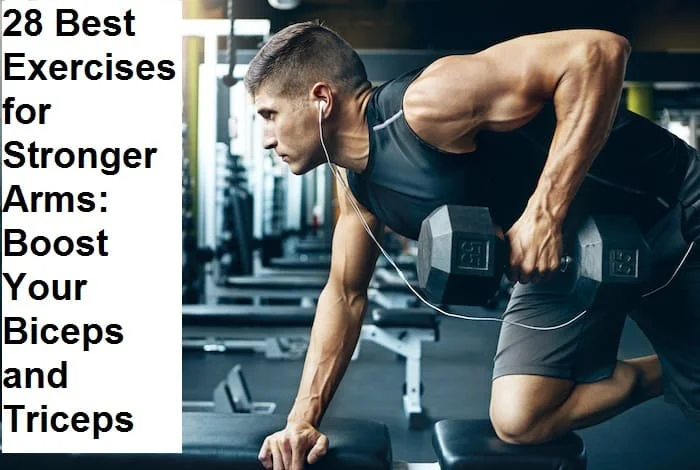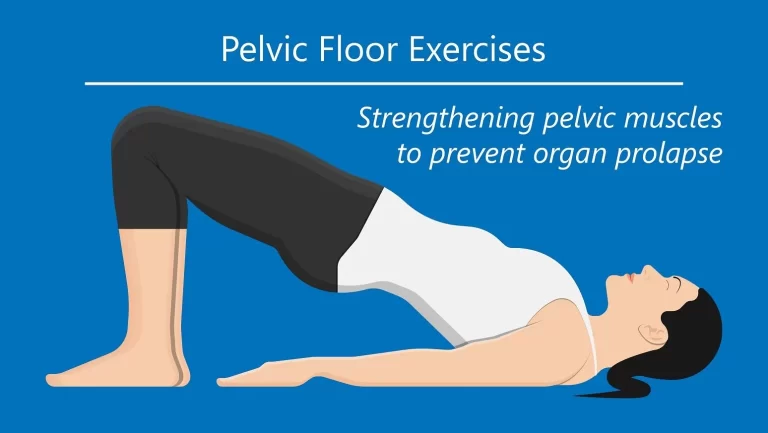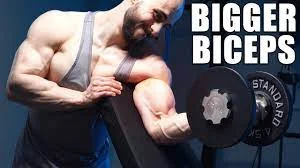28 Best Exercises for Stronger Arms: Boost Your Biceps and Triceps
Introduction
Improving arm strength is vital for enhancing overall upper body function and performance. Incorporating a well-rounded exercise regimen can lead to increased muscle mass, improved stability, and better functional ability in daily activities.
Several exercises are particularly effective for strengthening the arms, including those targeting the biceps, triceps, and forearms. These exercises can be tailored to individual fitness levels and goals, making them accessible to beginners and experienced athletes alike.
By integrating these exercises into a comprehensive workout routine, individuals can achieve stronger, more resilient arms, fostering greater physical well-being and endurance.
What is arm muscles?
The arm muscles are a group of muscles located in the upper limb that enable movement and provide strength and stability to the arm. They can be divided into two main groups: the muscles of the shoulder girdle and the muscles of the arm.
Muscles of the Shoulder Girdle:
- Deltoid: This is a big triangle muscle that wraps around the shoulder joint. It consists of three parts: anterior, middle, and posterior fibers. The deltoid muscle allows for various movements of the arm, including flexion, extension, abduction, and rotation.
- Trapezius: This is a large muscle that extends from the back of the neck to the upper back and shoulders. It helps in moving and stabilizing the shoulder blades, allowing for shoulder and arm movements.
- Levator scapulae: Located at the back and side of the neck, this muscle elevates the scapula (shoulder blade) and assists in rotating it.
- Rhomboids: These muscles lie between the spine and the scapulae. They retract and rotate the scapulae, helping to pull the shoulders back.
- Serratus anterior: Positioned on the side of the ribcage, this muscle protracts and stabilizes the scapulae, aiding in reaching forward or pushing movements.
Muscles of the Arm:
- Biceps brachii:
- This muscle is found in the upper arm’s front. It has two heads (long head and short head) that join to form a single tendon attached to the radius bone. The biceps brachii is responsible for flexing the elbow joint and supinating (rotating outward) the forearm.
- Triceps brachii:
- Situated on the back of the upper arm, this muscle has three heads (long head, lateral head, and medial head) that merge into a single tendon attached to the ulna bone. The triceps brachii extends the elbow joint and assists in stabilizing the shoulder.
- Brachialis:
- Positioned underneath the biceps brachii, this muscle lies between the humerus and ulna bones. It is responsible for elbow joint bending.
- Brachioradialis:
- Located on the lateral side of the forearm, this muscle aids in flexing the elbow joint and rotating the forearm.
- Pronator teres:
- Situated on the inner side of the forearm, this muscle pronates (rotates inward) the forearm, allowing the palm to face downwards.
These arm muscles work together to perform various movements such as lifting, pushing, pulling, and rotating the arm. Regular exercise and strength training can help develop and strengthen these muscles, improving overall arm strength and functionality.
Strengthening of arm muscle
Arm circles
This basic workout develops the biceps and triceps while targeting the shoulder muscles. You can make smaller or bigger circles, but make sure that you maintain tension down your arm during the full set of exercises.
To perform arm circles:
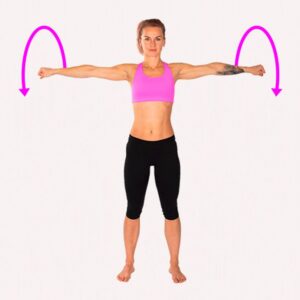
- Start with standing tall with your arms straight out to your sides and your muscles contracted down the length of your arm.
- Gradually create circles with your arms by rotating them around your shoulders while maintaining them straight and your elbows locked with tension.
- Do 3 sets of 10–20 repetitions in both directions.
- You can practice sets of large or small diameter circles to change the effort required.
Arm front raises
This exercise focuses on the front of your shoulder and isometrically strengthens your biceps and triceps. To make this more difficult, take two cans of soup or two water bottles for additional weight.
To perform arm front raises:
- start with standing tall with your arms out to the front, locked out straight with your thumbs in the direction of the ceiling.
- Lift your arms overhead while maintaining them straight and locked out until they point straight up overhead, with your upper arms blocking your ears when viewed from the side.
- Gradually drop your arms to the initiate position.
- Do 3 sets of 10–20 repetitions.
Arm lateral raises
This exercise focuses on the top of your shoulder and isometrically strengthens your biceps and triceps. To make this more difficult, grab two cans of soup or two water bottles for additional weight.
To perform arm lateral raises:
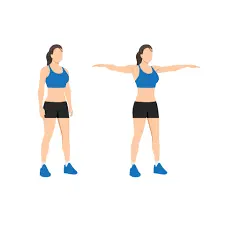
- Start with standing and your arms at your sides and your palms should be facing inward toward your hips.
- Maintain your arms extended and lift them to the side until your body creates a “T” when seen from the front.
- Gradually descend to the initiate position.
- That is 1 repetition.
- Do it again for 10–20 repetitions.
Wall angels
This exercise builds strength in the shoulder and triceps and improves shoulder mobility.
To perform wall angels:

- start with standing with your back against a wall with your knees flexed and your feet roughly 1–2 feet (about 0.5 meters) distance from the wall.
- Your head, upper back, and tailbone should be in touch with the wall.
- Flex your elbows to ninety degrees and lift your arms until your upper arms are parallel to the surface of the floor as if you are putting your hands up.
- do the extension of your arms overhead until they are straight.
- The goal is to keep your arms, head, upper back, and tailbone in touch with the wall.
- Go back to the initiate position.
- That is 1 repetition.
- Do it again for 3 sets of 10–12 repetitions.
Downward Dog to plank
This workout works on building the chest, shoulders, and triceps. It is the best way to start building strength at the top of a pushup position.
To perform Downward Dog to Plank:
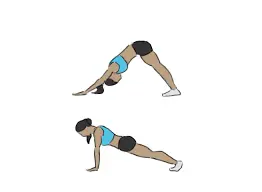
- Start in a pushup plank position with your hands beneath your shoulders and your arms extended.
- You can begin with your knees on the floor if the pushup plank position is more difficult.
- Elevate your hips and press your arms back to enter the Downward Dog Pose. If you start from your knees, you will be lifting your knees off of the floor once you have pushed back enough to do so.
- Stabilize briefly in the Downward Dog Pose before going back to the initiate position.
- That is 1 repetition.
- do it again for 3 sets of 10–12 repetitions.
Plank tap
This exercise is a plank variation that strengthens your shoulders, triceps, and biceps muscles.
To perform the plank tap:
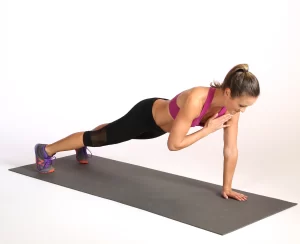
- Start in a pushup plank position with your hands beneath your shoulders and your arms lengthen.
- maintain your spine neutral.
- in order to make the exercise more difficult, place your feet closer.
- To make it easier, widen your feet.
- Take your left hand up to your right shoulder and tap it before taking back your hand to the ground.
- Do it again with your right hand and left shoulder.
- Perform three sets of 10-12 rounds on each side.
Pushup
The classic pushup strengthens the chest, shoulders, and triceps without any equipment. You will also need to brace your core to keep the position, which adds a bonus core component to this arm exercise.
Perform the pushups on your knees if the standard variation is too difficult.
To perform a pushup:
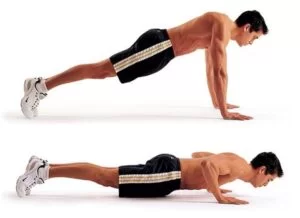
- Start in a pushup position with your hands beneath your shoulders, spine neutral, and legs extended.
- If needed, place your knees on the floor to decrease the difficulty level.
- Descend your whole body in unison in the direction of the floor by bending at the elbow.
- Maintain your elbows near to your sides or at about a forty-five–degree angle.
- Descend your chest until your upper arm comes parallel to the surface of the floor.
- Push with the floor to move back to the top position, holding control the whole time.
- Do it again for 3 sets of 10–12 repetitions.
- If the sets become more challenging, you can revert to the knees-down variation.
Strict (Military) Push-Up
Mainly focuses on the chest and triceps muscles and also strengthens the shoulders, biceps, and core muscles.
To perform Strict (Military) Push-Up
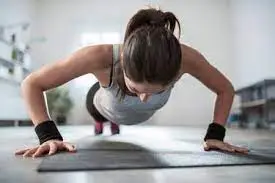
- Begin in a high-plank position, and your hands shoulder-width apart, and your arms should be fully extended hands, elbows, and shoulders all in line.
- Maintain your feet closer or no more than 12 inches distance.
- Brace your core muscles to maintain your body in a straight line from head to heels.
- From here, flex your elbows, and maintain them tracking back alongside your body to better target the triceps to descend your chest to a little below the level of your bent elbow.
- After that, for a single repetition, push yourself back to the high-plank pose.
- Maintain your spine neutral (no sagging or arching of the back or the butt) and your hips at a level during the whole movement.
- Do 10 to 15 repetitions.
Dumbbell Curl
Mainly focuses on the biceps and also strengthens muscles in the forearms and shoulders.
To perform Dumbbell Curl
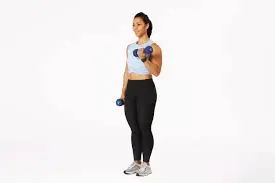
- Take a dumbbell in each hand, and your arms should be at your sides, palms should be facing inward.
- Stand tall, with your shoulders backward and downward and your core should be engaged.
- One arm at a time, gradually raise the weight and turn your wrist 90 degrees to the outside.
- Curl the dumbbell all the way to your shoulder and bend the elbow joint over its full range of motion.
- Hold for a second, then gradually reverse the movement to the initiate position for one repetition.
- Do it again on the other arm, and alternate sides every repetition.
- Practice 10 to 15 repetitions on both sides.
Make sure you complete each curl with control, and keep an upright and still torso (do not let momentum aid the movement). Moving back and forth between repetitions or sinking your shoulders indicates that the weight is too big for your biceps alone, and non-target muscle groups are being stimulated to adjust.
Triceps Extension
It isolates the triceps while strengthening and stabilizing the shoulders and core.
To perform Triceps Extension
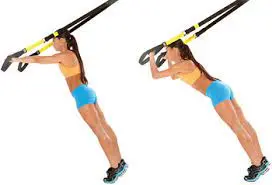
- You can perform this movement using either a TRX suspension system or resistance bands.
- Set the straps to midlength if using TRX, so the handles are at hip and chest level.
- Hold the handles, palms should be downward, and stand under the anchor point with your feet hip-width distance.
- Extend your arms, and maintain them parallel to the surface of the floor at chest level.
- Then tilt in a forward direction into the straps, and move your weight onto your toes (your body should be tilted forward between 30 and 45 degrees).
- This is the initiate position.
- From here, flex your elbows to descend your body as far as you can easily go.
- Press with the triceps to lengthen your elbows, and go back to the initiate position for one repetition.
- maintain your shoulders still and your body in a straight line from heel to head during the movement to isolate the triceps.
- Do 10 to 15 repetitions.
In order to make it more challenging by stepping back or lowering the handles to increase the angle of your body relative to the ground.
If you do not have a TRX suspension system, wrap a resistance band over a high, strong object, like a pull-up bar, and grab one end in each hand. Move back to raise the band tension (the farther back, the more difficult), and keep your elbows at your sides, bending to ninety degrees. Engage your core, slightly bend your body forward so your weight is on your toes, then gradually stretch your elbows until they are straight. For one repetition, gradually reverse the movement back to the beginning position. To isolate the triceps, keep your shoulders motionless during the movement (just your forearms ought to move, swinging from the elbow).
Step back further or switch to a heavier band to raise the resistance.
Bench (Triceps) Dips
Mainly focuses on the triceps and also strengthens the shoulders, chest, and back.
To perform Bench (Triceps) Dips
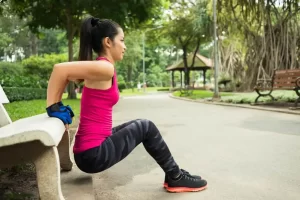
- start with sitting on a sturdy bench, and hold the front edge with your palms facing down and your fingers should be facing forward.
- Either keep your heels on the ground with your legs extended out in front of you (harder) or your feet flat with your knees bent (easier).
- brace your core, and press down with your palms to raise your tailbone off the bench.
- Move your weight forward slightly to clear the bench’s lip, then bend your elbows to gradually descend your body until your elbows are bent to around 90 degrees or as far as you can go easily.
- For one repetition, push back up with your triceps till your arms are straight.
- Repeat for 10 to 15 times more.
Raise your feet on a box or an exercise ball to make it more difficult (this demands additional core activation for stability), or have a friend lay a plate weight in your lap. Build up to completing full dips with your feet off the ground on parallel bars, gymnastic rings, or suspension straps.
Cactus Arms
To perform Cactus Arms
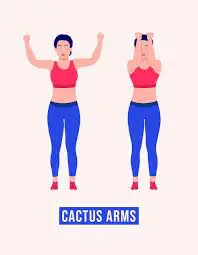
- Begin with standing on the mat, feet hip-width distance.
- Hold dumbbells in both hands, take elbows closer and upward so arms create ninety-degree angles, and elbows should be at shoulder level.
- Maintaining core stable, open elbows as wide as possible.
- take them closer again.
- That is one repetition.
- do it again for several repetitions.
Upright Row
To perform Upright Row
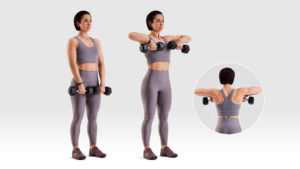
- Begin with standing with feet hip-width distance, with arms kept in front of the body and a holding dumbbell in each hand.
- Raise dumbbells by lifting elbows until they reach chest height.
- Gradually descend them back down to the waist in a controlled manner,
- That is one repetition.
- do it again for several repetitions.
Lying Overhead Triceps Extension
To perform Lying Overhead Triceps Extension
- Start with lying on the back knees should be bent and feet should be placed flat on the Surface of the floor about a foot from the butt.
- Grasp a dumbbell in each hand and stretch arms up over shoulders, palms should be facing toward each other.
- Gradually bend at the elbows to take weights in the direction of the floor, close to the temples.
- hold for a few seconds, then, gradually extend your arms to take the weights back overhead.
- That is one repetition.
- do it again for several repetitions.
Alternating Bent-Over Row
To perform Alternating Bent-Over Row
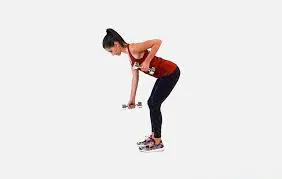
- Begin with standing feet at a hip distance away keeping one dumbbell in each hand and palms should be facing each other.
- Lean forward at the hips, maintaining the head in line with the tailbone.
- Engage the core, and pull the right elbow backward until the right wrist is near the ribs.
- Descend with control to come back to the initiate position.
- Engaging core, pull the left elbow back until the left wrist is near the ribs.
- Descend with control to go back to the initiate position.
- That is 1 repetition.
- do it again for several repetitions.
For any single-side moves, do not forget to change sides and complete all the repetitions on the other side before moving onward.
Triceps Kickback
To perform Triceps Kickback
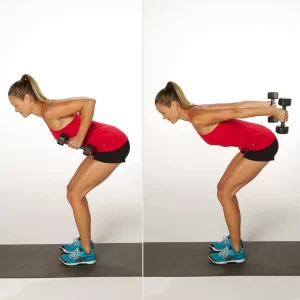
- Initiate with standing with feet two-fists-width away with knees should be bent.
- Tilt forward slightly, with a dumbbell in each hand, and elbows should be at 90 degrees by the sides.
- Press dumbbells backward and upward, and as you straighten your arms, squeeze your triceps muscles.
- descend weights with control to go back to the initiate position.
- That is 1 repetition.
- Do it again for several repetitions.
Curtsy Lunge with Biceps Curl
To perform Curtsy Lunge with Biceps Curl
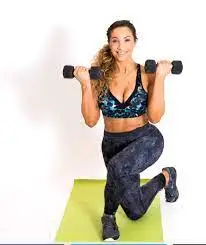
- Initiate with standing with feet hip-width distance taking a dumbbell in each hand.
- Take a big step backward side with the right leg, crossing it behind the left while maintaining hips facing forward.
- Flex your knees and descend down until the right knee almost touches the surface of the ground.
- At the same time, bend your elbows and take the weights toward your shoulders, maintaining elbows pointing downward.
- Step with your left heel as you come to begin, standing tall.
- That is 1 repetition.
- Do it again for several repetitions.
Renegade Row
To perform Renegade Row
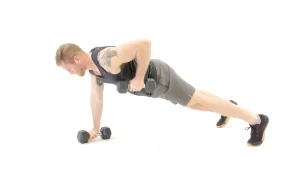
- Begin in plank position, and take dumbbells in either hand on the floor.
- Pull the right elbow in the direction of the ceiling until the right wrist is near the ribs, then go back to the ground.
- Do it again on the opposite side.
- That is 1 repetition.
- Do it again for several repetitions.
Rear Delt Fly
To perform Rear Delt Fly
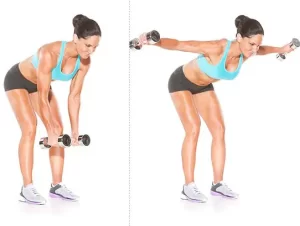
- Begin with standing with feet hip-width distance and knees should be slightly bent.
- Lean forward at the hips and let arms hang straight down from shoulders, palms should be facing your body, taking a pair of dumbbells.
- Lift both arms out to the sides with elbows slightly flexed and compress shoulder blades at the same time.
- Descend weights in a controlled manner to go back to the initiate position.
- That is 1 repetition.
- Do it again for several repetitions.
Alternating Military Press
To perform Alternating Military Press
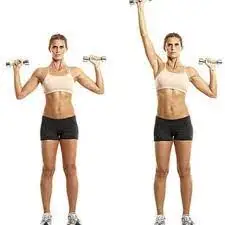
- Begin with standing or kneeling with the right leg forward, tailbone tucked, and core braced.
- Take elbows upward and out so arms create 90-degree angles, like a field goal, with dumbbells in hands.
- Press the right arm up straight, until the right bicep is near the right ear.
- Descend down to come back to field goal position.
- Do it again with the left arm.
- That is 1 repetition.
- Do it again for several repetitions.
Seated Arnold Press
To perform Seated Arnold Press
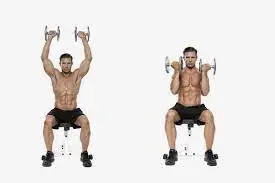
- Begin with seated with legs fully extended out in front of the body with a slight bend in the knees.
- Grasp a dumbbell in each hand in front of the face and palms should be facing each other and elbows creating 90-degree angles.
- Extend elbows upwards and out to sides in a little upward arc motion till palms face forward.
- Move elbows down and back together in the same arc.
- That is 1 repetition.
- Do it again for several repetitions.
Overhead Triceps Extension
To perform Overhead Triceps Extension
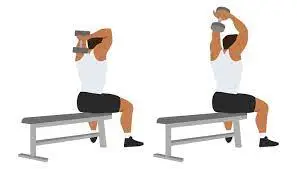
- Begin with standing, holding one dumbbell with both hands and raising the weight overhead, arms straight, feet should be hip-width distance.
- Maintain upper arms by ears, bend your elbows to descend the weight gradually back side of your head, and hold for a few seconds.
- Straighten arms, going back to the initiate position.
- That is 1 repetition.
- Do it again for several repetitions.
Dumbbell Floor Press
To perform Dumbbell Floor Press

- Start with lying on the back with knees should be bent and feet should be placed flat on the floor, about a foot from the butt.
- Take a dumbbell in each hand and stretch your arms up over your shoulders, palms should be facing toward each other.
- With control motion, bend arms and descend them to sides until triceps touch the surface of the floor (dumbbells will still be over wrists).
- Elbows should create a 45-degree angle with the body.
- Gradually reverse the movement and go back to the beginning position.
- That is 1 repetition.
- Do it again for several repetitions.
Plank with Biceps Curl
To perform Plank with Biceps Curl
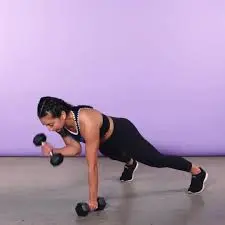
- Begin in plank position, taking dumbbells in your hands on the floor, directly under your shoulders.
- Maintain your core and hips stable, gradually taking the right dumbbell in the direction of the right shoulder.
- Descend it back down with control movement.
- That is 1 repetition.
- Do it again for several repetitions.
Single-Arm Dumbbell Floor Press
To perform Single-Arm Dumbbell Floor Press

- Start with lying on your back your knees should be bent and your feet should be flat on the ground.
- Take a dumbbell in the right hand with the elbow bent and the tricep placed on the floor.
- The elbow should create a 45-degree angle with the body.
- Press the dumbbell and stretch your arm upward over your chest, your palm should be facing away from you.
- Reverse the movement with control movement and go back to the initiate position.
- That is 1 repetition.
- Do it again for several repetitions.
Alternating Dumbbell Floor Press
To perform Alternating Dumbbell Floor Press

- Start with lying on the bench your back and your knees should be bent and your feet should be placed flat on the surface of the floor.
- Take a dumbbell in each hand and rest your upper arms on the floor with elbows should be bent at 90 degrees.
- The upper arm should form a 45-degree angle with your body.
- Straighten your right arm above your shoulder.
- Slowly bend the right arm and lower it to the side, until the right elbow touches the ground.
- That is 1 repetition.
- Do it again for several repetitions.
Write Your Name
How to:
- Begin by standing with both hands on a single dumbbell.
- Raise your arms to chest level in front of you.
- Draw your name in the air gently and carefully.
- Each letter is worth one repetition.
Alternating Front and Lateral Raise
To perform Alternating Front and Lateral Raise

- Start with standing and knees slightly bent, feet hips distance apart, and arms extended at sides holding dumbbells in each hand.
- Lift arms in front until hands reach shoulder level.
- Lower arms with control to sides.
- Lift arms out wide until parallel to the surface of the ground.
- Lower arms gradually go back to the initiate position.
- That is 1 repetition.
- Do it again for several repetitions.
Benefits of arm strengthening exercises
There are several benefits of arm strengthening exercises:
- Increased muscle strength: Arm strengthening exercises target the specific muscles in the arms, such as the biceps, triceps, and deltoids. Regular exercise can help increase muscle strength, allowing you to perform everyday tasks with ease and preventing muscle weakness or fatigue.
- Improved functional abilities: Strong arm muscles are essential for performing various daily activities, such as carrying groceries, lifting objects, pushing or pulling heavy items, and performing household chores. By strengthening your arm muscles, you can improve your overall functional abilities and make these tasks easier and more efficient.
- Enhanced athletic performance: Strong arm muscles are crucial for athletes participating in sports that involve throwing, swinging, or lifting, such as baseball, golf, tennis, and weightlifting. By strengthening your arm muscles, you can improve your performance in these sports by generating more power, speed, and accuracy in your arm movements.
- Injury prevention: Weak arm muscles can increase the risk of injuries, such as strains, sprains, and overuse injuries. By regularly strengthening your arm muscles, you can help prevent these injuries by improving muscle stability and endurance. Strong arm muscles also provide better support and protection to the joints, reducing the risk of joint-related injuries.
- Better posture and balance: Strong arm muscles help with balance as well as posture. The muscles of the shoulder girdle play a significant role in stabilizing the shoulder blades and maintaining proper shoulder alignment. By strengthening these muscles, you can improve your posture and reduce the risk of developing shoulder or neck pain.
- Increased calorie burn: Engaging in arm strengthening exercises can help increase your overall calorie burn during workouts. Strength training exercises, including those targeting the arms, can increase muscle mass, which in turn increases your basal metabolic rate (BMR). This means that even at rest, you will burn more calories throughout the day.
- Boosted confidence and self-esteem: Developing strong and toned arm muscles can enhance your physical appearance and boost your confidence and self-esteem. Feeling strong and capable in your arms can improve your body image and overall self-perception.
It is important to note that proper form, technique, and progression are crucial when performing arm strengthening exercises. It is recommended to consult with a fitness professional or trainer to ensure you are using the correct form and appropriate weights or resistance for your fitness level.
FAQ
What are some examples of arm-strengthening exercises?
Examples of arm-strengthening exercises include bicep curls, tricep dips, push-ups, overhead presses, dumbbell rows, and resistance band exercises.
How often should I do arm strengthening exercises?
It is recommended to perform arm strengthening exercises at least two to three times per week. Permit time between sessions for rest days so you can let your muscles heal and rebuild.
Can I do arm strengthening exercises without weights?
Yes, there are many arm-strengthening exercises that can be done without weights. These include push-ups, tricep dips, planks, and various bodyweight exercises that target the arms.
How long does it take to see results from arm strengthening exercises?
The time it takes to see results from arm strengthening exercises can vary depending on factors such as your current fitness level, frequency of exercise, and genetics. However, with consistent effort and proper form, you can typically start to see improvements in muscle strength and tone within a few weeks to a couple of months.
Can arm strengthening exercises help with weight loss?
While arm strengthening exercises alone may not directly lead to significant weight loss, they can contribute to an overall calorie burn and increased muscle mass. This can help boost your metabolism and potentially aid in weight loss when combined with a balanced diet and regular cardiovascular exercise.
Are there any precautions or contraindications for arm strengthening exercises?
It’s critical to pay attention to your body and refrain from doing any workouts that make you feel pain or discomfort. If you have any pre-existing injuries or conditions affecting your arms or shoulders, it is recommended to consult with a healthcare professional before starting an arm-strengthening exercise routine. Additionally, always use proper form and technique to minimize the risk of injury.
References
- Nied, J., & Aloian, A. (2023, September 27). 20 Arm-Toning Exercises That Only Require A Pair Of Dumbbells. Women’s Health. https://www.womenshealthmag.com/fitness/a20702885/arm-toning-exercises/
- Tucker, A., CPT, M. L., CPT, A. M. W., & CPT, C. S. (2022, April 12). Arms Workouts for Women: 21 Bodyweight Arm Moves to Mix-and-Match Your Own Routine. SELF. https://www.self.com/gallery/sexy-arms-no-equipment-slideshow
- Carpenter, H., & Carpenter, H. (2022, October 4). 7 Simple Arm-Strengthening Exercises. Outside Online. https://www.outsideonline.com/health/training-performance/arm-strengthening-exercises-weights/
- Cpt, T. R. B. (2023, April 29). 8 Weight-Free Exercises to Tone Your Arms. Healthline. https://www.healthline.com/health/fitness-exercise/arm-exercises-no-weights#weight-free-arm-exercises
- Image: Stuart, J. (2021, November 26). Side Laterals to Front Raise — BETTER BODY ACADEMY. BETTER BODY ACADEMY. https://www.betterbodyacademy.com/trainingshoulders/side-laterals-to-front-raise
- Image: Neudecker, K. (2023, March 17). How to Do the Incline Dumbbell Press & Which Angle Is Best to Supersize Your Chest? Men’s Health. https://www.menshealth.com/uk/fitness/a735422/incline-dumbbell-press/
- Image: M., & M. (2022, March 23). Alternating Dumbbell Press: How to, Benefits, Muscles Worked, Variations, Mistakes To Avoid And Alternative Exercises. Fitness Baddies. https://www.fitnessbaddies.com/alternating-dumbbell-press/
- Image: Dumbbell Floor Press – Muscle & Fitness. (2017, November 3). Muscle & Fitness. https://www.muscleandfitness.com/exercise/workouts/chest-exercises/dumbbell-floor-press/
- Image: 16 Biceps Exercises That Will Get Your Arms Crazy-Sculpted With Just A Pair Of Dumbbells. (2022, June 1). Women’s Health. https://www.womenshealthmag.com/fitness/a24851851/bicep-workouts-for-women/
- Image: Triceps Extension: Barbell Vs. Dumbbell. (2019, October 15). SportsRec. https://www.sportsrec.com/510882-triceps-extension-barbell-vs-dumbbell.html#google_vignette
- Image: Seated Arnold Press Workout to Get Lean & Awesome Shoulders | DMoose. (n.d.). DMoose. https://www.dmoose.com/blogs/shoulders/seated-arnold-press
- Image: Alternating Dumbbell Shoulder Press. (n.d.). skimble.com. https://www.skimble.com/exercises/27339-alternating-dumbbell-shoulder-press-how-to-do-exercise
- Image: Mayz, B., & Mayz, B. (2023, January 2). Rear Delt Fly: How To (Video), Muscles Worked, Benefits, & Alternatives Exercises. FitLifeFanatics. https://fitlifefanatics.com/rear-delt-fly/
- Image: Mayz, B., & Mayz, B. (2023, January 2). Rear Delt Fly: How To (Video), Muscles Worked, Benefits, & Alternatives Exercises. FitLifeFanatics. https://fitlifefanatics.com/rear-delt-fly/
- Image: Cpt, B. G. (2021, November 2). How To Do Skull Crushers With Dumbbells Like A Total Badass. Women’s Health. https://www.womenshealthmag.com/fitness/a28773681/skull-crushers/
- Image: Putra, L. (2022, December 22). Download the Woman doing Double arm side or lateral raises exercise. Raise both arms laterally until horizontal. . .. Vecteezy. https://www.vecteezy.com/vector-art/16137894-woman-doing-double-arm-side-or-lateral-raises-exercise-raise-both-arms-laterally-until-horizontal-flat-vector-illustration-isolated-on-white-background
- Image: Cactus arms exercise woman workout fitness aerobic and exercises Premium Vector. (2021, October 7). Freepik. https://www.freepik.com/premium-vector/cactus-arms-exercise-woman-workout-fitness-aerobic-exercises_19285861.htm
- Image: Craig, A. (2018, December 14). TRX Triceps Extension –. https://personallevelfitness.com/trx-triceps-extension/
- Image: Rogers, P. (2022, November 7). How to Do Biceps Curls: Proper Form, Variations, and Common Mistakes. Verywell Fit. https://www.verywellfit.com/how-to-do-the-biceps-arm-curl-3498604
- Image: Booe, M. (2019, June 19). The Difference Between Standard Push-Ups and Military Push-Ups. LIVESTRONG.COM. https://www.livestrong.com/article/541574-the-difference-between-standard-pushups-and-military-pushups/
- Image: Plank to the downward-facing dog – GoFitnessPlan. (n.d.). GoFitnessPlan. https://www.gofitnessplan.com/exercises/plank-to-downward-facing-dog

